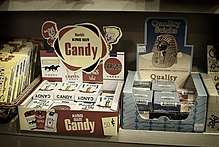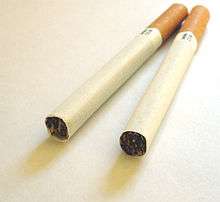Candy cigarette
Candy cigarettes are a candy introduced in the late 19th century[1] made out of chalky sugar, bubblegum or chocolate, wrapped in paper and packaged and branded so as to resemble cigarettes. Some products contain powdered sugar hidden in the wrapper, allowing the user to blow into the cigarette and produce a cloud of sugar that imitates smoke, which comes out of the other end.
 | |
| Alternative names | Candy sticks, Candy stix |
|---|---|
| Type | Confectionery |
| Main ingredients | Sugar |
| Variations | Candy, bubble gum, chocolate |
Candy cigarettes' place on the market has long been controversial because many critics believe the candy desensitizes children, leading them to become smokers later in life.[2] Candy cigarettes can also serve as a way to market cigarettes to children, as many candy cigarettes have branding nearly identical to cigarette brands.[3] Because of this, the selling of candy cigarettes has been banned in several countries even though they continue to be manufactured and consumed in many parts of the world. However, many manufacturers now describe their products as candy sticks, bubble gum, or simply candy.[4]
Tobacco companies and candy cigarette manufacturers have cooperated to make candy cigarettes. Tobacco companies have allowed candy cigarette companies to use their branding;[3] Brown and Williamson has gone as far as to send copies of its labels to candy cigarette companies.[5] After the 1964 Surgeon General's report on smoking and health criticized candy cigarettes for "trying to lure youngsters into the smoking habit", tobacco companies began to distance themselves from candy cigarettes, although trademark infringement lawsuits against candy cigarette manufacturers have been rare.[3]
A 1990 study found that sixth graders who used candy cigarettes were twice as likely to smoke cigarettes than those who did not use candy cigarettes.[6] A 2007 study surveyed 25,887 adults and found that "[c]andy cigarette use was reported by 88% of both current and former smokers and 78% of never smokers", a statistically significant difference that the authors suggested indicates a connection between candy cigarette use as a child and smoking as an adult.[7][8]
In America it was reported erroneously in 2010 that the Family Smoking and Prevention Control Act[9] bans candy cigarettes.[10] However, the rule bans any form of added flavoring in tobacco cigarettes other than menthol.[11] It does not regulate the candy industry. Popeye Cigarettes marketed using the Popeye character were sold for a while and had red tips (to look like a lit cigarette) before being renamed candy sticks and being manufactured without the red tip. Most candy cigarettes continue to be manufactured in the United States, with the largest maker of candy cigarettes, World Confections Inc, being based in New Jersey.[5]
Sales laws
| Country | Law |
|---|---|
| Australia | Banned[3] |
| Bahrain | Banned[3] |
| Brazil | Banned[12] |
| Canada | Federal law prohibits candy cigarette branding that resembles real cigarette branding and vice versa[3][13] |
| Chile | Banned |
| Denmark | Banned |
| Finland | Banned[8] |
| France | Banned |
| Ireland | Banned[14] |
| Kuwait | Banned[3] |
| New Zealand | Banned[12] |
| Norway | Banned[3] |
| Oman | Banned[3] |
| Philippines | Strictly enforced, discouraged use |
| Portugal | Banned |
| Qatar | Banned[3] |
| Saudi Arabia | Banned[8] |
| South Africa | Banned in terms of section 4(3) of the Tobacco Products Control Act, 1993[15][16] |
| South Korea | Banned |
| Spain | Banned[17] |
| Sweden | Banned |
| Thailand | Banned[18] |
| Turkey | Banned |
| United Arab Emirates | Banned[3] |
| United Kingdom | Banned[8] |
| Territory | Law |
|---|---|
| New South Wales | Banned (1999)[19] |
| North Dakota | Enacted a ban on candy cigarettes from 1953 until 1967.[2] |
| Nunavut | Banned all products that resemble cigarettes.[20] |
| Tennessee | Banned[18] |
| Locality | Law |
|---|---|
| St. Paul, Minnesota | Banned (April 2009)[18] |
References
- "Roundabouts". The American Stationer. 22 November 1888. Retrieved 11 July 2019.
- Lloyd, Robin (June 18, 2007). "Study Links Candy Cigarettes to Smoking". LiveScience. Retrieved August 31, 2008.
- Klein, Jonathan D; Clair, Steve St (2000-08-05). "Do candy cigarettes encourage young people to smoke?". BMJ : British Medical Journal. 321 (7257): 362–365. ISSN 0959-8138. PMC 1118335. PMID 10926600.
- "World Candies". Cardhouse.com. Retrieved 9 December 2008.
- Raymond, Adam K. (29 September 2016). "How the Hell Are Candy Cigarettes Still a Thing?". Thrillist. Retrieved 11 July 2019.
- Klein, J. D.; Forehand, B.; Oliveri, J.; Patterson, C. J.; Kupersmidt, J. B.; Strecher, V. (January 1992). "Candy cigarettes: do they encourage children's smoking?". Pediatrics. 89 (1): 27–31. ISSN 0031-4005. PMID 1728016.
- Klein, Jonathan D.; Thomas, Randall K.; Sutter, Erika J. (July 2007). "History of childhood candy cigarette use is associated with tobacco smoking by adults". Preventive Medicine. Elsevier. 45 (1): 26–30. doi:10.1016/j.ypmed.2007.04.006. PMID 17532370.
- Mestel, Rosie (September 15, 2012). "Candy cigarettes and 'Toddlers & Tiaras'". California Life & Style. Los Angeles Times. Retrieved 26 May 2019.
- Quinn, Kathleen (22 September 2009). "Candy and Fruit Flavored Cigarettes Now Illegal in United States; Step is First Under New Tobacco Law". U.S. Food and Drug Administration. Retrieved 11 July 2019.
- RTT Staff Writer (24 June 2010). "Candy Cigarettes Officially Banned By FDA". RTTNews. Retrieved 13 January 2013.
- FDA. "Tobacco Products" FDA U.S. Food and Drug Administration. Archived August 23, 2011, at the Library of Congress Web Archives
- Patterson, Freda; Farquhar, William B. (2019-07-01). "Cigarettes at ¢35 a pack, in 2019…". J Epidemiol Community Health. 73 (7): 589–589. doi:10.1136/jech-2019-212333. ISSN 1470-2738. PMC 6853065. PMID 30898853.
- "Tobacco and Vaping Products Act". Consolidated federal laws of Canada. 24 April 2019. Retrieved 11 July 2019.
- Norgard, Elizabeth (4 November 2008). "Chocolate cigarettes labelled a gateway drug". The Local de. Retrieved 11 July 2019.
- "Tobacco Products Control Act 83 of 1993". of 23 June 1993 (PDF).
- "Tough New Tobacco Products Control Legislation Comes into Effect". Sabinet. August 28, 2009.
- "¿Recordáis los cigarrillos de chocolate?". Madre reciente. 23 October 2011.
- Walsh, Paul (December 27, 2012). "St. Paul shop caught with smoking gum". Star Tribune. p. B1,B4. Retrieved 26 May 2019.
- Burke, Kelly (August 16, 2008). "Banned, but choc cigarettes creep back". The Sydney Morning Herald. Retrieved 26 May 2019.
- Nunavut Tobacco Control Act 2003 Archived 2016-01-13 at the Wayback Machine, Section 4
